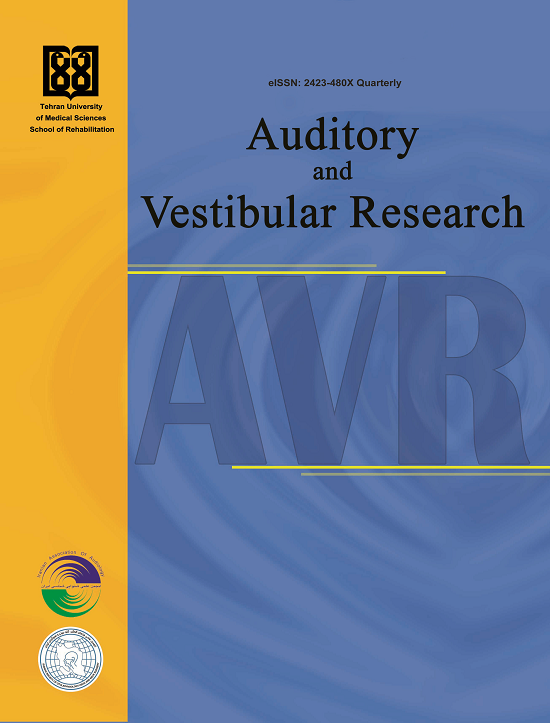Clinical Utility of the Tamil Speech-in-Noise Test for Detecting Hidden Hearing Loss in Tinnitus with Normal Audiograms: Insights from Behavioral and Electrophysiological Measures
Abstract
Background and Aim: Tinnitus often occurs in individuals with normal audiograms and may reflect hidden hearing loss (HHL). Conventional audiometry fails to detect these suprathreshold deficits. This study evaluated the clinical utility of a validated Tamil Speech-in-Noise (SIN) test, supported by otoacoustic emissions (OAEs) and auditory brainstem responses (ABRs), in detecting HHL in tinnitus patients.
Methods: Thirty native Tamil-speaking adults were recruited: 15 with chronic bilateral tinnitus and 15 matched controls. All had normal hearing thresholds. Participants underwent the Tamil SIN test, transient evoked OAEs, distortion product OAEs, and click-evoked ABRs. Group differences were analyzed using independent-sample t-tests.
Results: The tinnitus group showed significantly higher SNR-50 thresholds and SNR loss compared to controls, indicating impaired SIN perception. Both DPOAEs and TEOAEs were significantly reduced across frequencies, confirming cochlear dysfunction despite normal audiograms. ABR analysis revealed delayed Wave I and Wave III latencies, with marginal prolongation of Wave V, indicating early auditory nerve involvement.
Conclusion: Tinnitus patients with normal audiograms demonstrate measurable auditory deficits, reflecting HHL. The Tamil SIN test, complemented by OAE and ABR, provides a culturally appropriate and sensitive protocol for early detection. These findings highlight the limitations of pure-tone audiometry and support integrating multimodal assessments into tinnitus evaluations.
2. Baguley D, McFerran D, Hall D. Tinnitus. Lancet. 2013;382(9904):1600-7. [DOI:10.1016/S0140-6736(13)60142-7]
3. Henry JA, Dennis KC, Schechter MA. General review of tinnitus: prevalence, mechanisms, effects, and management. J Speech Lang Hear Res. 2005;48(5):1204-35. [DOI:10.1044/1092-4388(2005/084)]
4. Weisz N, Hartmann T, Dohrmann K, Schlee W, Norena A. High-frequency tinnitus without hearing loss does not mean absence of deafferentation. Hear Res. 2006;222(1-2):108-14. [DOI:10.1016/j.heares.2006.09.003]
5. Schaette R, McAlpine D. Tinnitus with a normal audiogram: physiological evidence for hidden hearing loss and computational model. J Neurosci. 2011;31(38):13452-7. [DOI:10.1523/JNEUROSCI.2156-11.2011]
6. Gu JW, Herrmann BS, Levine RA, Melcher JR. Brainstem auditory evoked potentials suggest a role for the ventral cochlear nucleus in tinnitus. J Assoc Res Otolaryngol. 2012;13(6):819-33. [DOI:10.1007/s10162-012-0344-1]
7. Kujawa SG, Liberman MC. Adding insult to injury: cochlear nerve degeneration after "temporary" noise-induced hearing loss. J Neurosci. 2009;29(45):14077-85. [DOI:10.1523/JNEUROSCI.2845-09.2009]
8. Sergeyenko Y, Lall K, Liberman MC, Kujawa SG. Age-related cochlear synaptopathy: an early-onset contributor to auditory functional decline. J Neurosci. 2013;33(34):13686-94. [DOI:10.1523/JNEUROSCI.1783-13.2013]
9. Liberman MC, Epstein MJ, Cleveland SS, Wang H, Maison SF. Toward a Differential Diagnosis of Hidden Hearing Loss in Humans. PLoS One. 2016;11(9):e0162726. [DOI:10.1371/journal.pone.0162726]
10. Guest H, Munro KJ, Prendergast G, Millman RE, Plack CJ. Impaired speech perception in noise with a normal audiogram: No evidence for cochlear synaptopathy and no relation to lifetime noise exposure. Hear Res. 2018;364:142-51. [DOI:10.1016/j.heares.2018.03.008]
11. Bharadwaj HM, Verhulst S, Shaheen L, Liberman MC, Shinn-Cunningham BG. Cochlear neuropathy and the coding of supra-threshold sound. Front Syst Neurosci. 2014;8:26. [DOI:10.3389/fnsys.2014.00026]
12. Wang Y, Spence MM, Jongman A, Sereno JA. Training American listeners to perceive Mandarin tones. J Acoust Soc Am. 1999;106(6):3649-58. [DOI:10.1121/1.428217]
13. Hervais-Adelman A, Pefkou M, Golestani N. Bilingual speech-in-noise: neural bases of semantic context use in the native language. Brain Lang. 2014;132:1-6. [DOI:10.1016/j.bandl.2014.01.009]
14. Kumar A. Development of Sentences for A Tamil Speech-in-Noise Test: Lists for Children, Younger Adults, and Older Adults. J Hear Sci. 2025;15(1):16-24. [DOI:10.17430/jhs/203028]
15. Lapsley Miller JA, Marshall L, Heller LM, Hughes LM. Low-level otoacoustic emissions may predict susceptibility to noise-induced hearing loss. J Acoust Soc Am. 2006;120(1):280-96. [DOI:10.1121/1.2204437]
16. Paul BT, Bruce IC, Roberts LE. Evidence that hidden hearing loss underlies amplitude modulation encoding deficits in individuals with and without tinnitus. Hear Res. 2017;344:170-182. [DOI:10.1016/j.heares.2016.11.010]
17. Emadi M, Rezaei M, Najafi S, Faramarzi A, Farahani F. Comparison of the Transient Evoked Otoacoustic Emissions (TEOAEs) and Distortion Products Otoacoustic Emissions (DPOAEs) in Normal Hearing Subjects with and Without Tinnitus. Indian J Otolaryngol Head Neck Surg. 2018;70(1):115-18. [DOI:10.1007/s12070-015-0824-9]
18. Tillman TW, Olsen WO. Speech audiometry. In: Jerger J, editor. Modern Developments in Audiology. 2nd ed. New York: Academic Press; 1973. p. 37-74).
19. Mamatha NM, Yathiraj A. Variation in speech perception in noise as a function of age in typically developing children. Journal of Indian Speech Language & Hearing Association. 2019;33(1):32–7. [DOI:10.4103/jisha.JISHA_17_18]
20. Ghosh V, Devananda D, Harisanker SB, Kumar H. Speech perception in noise in malayalam-speaking young adults with normal hearing. J Hear Sci. 2024;14(2):33-8. [DOI:10.17430/jhs/191377]
21. Vielsmeier V, Kreuzer PM, Haubner F, Steffens T, Semmler PR, Kleinjung T, et al. Speech Comprehension Difficulties in Chronic Tinnitus and Its Relation to Hyperacusis. Front Aging Neurosci. 2016;8:293. [DOI:10.3389/fnagi.2016.00293]
22. Gilles A, Schlee W, Rabau S, Wouters K, Fransen E, Van de Heyning P. Decreased Speech-In-Noise Understanding in Young Adults with Tinnitus. Front Neurosci. 2016;10:288. [DOI:10.3389/fnins.2016.00288]
23. Modh D, Katarkar A, Alam N, Jain A, Shah P. Relation of distortion product otoacoustic emission and tinnitus in normal hearing patients: a pilot study. Noise Health. 2014;16(69):69-72. [DOI:10.4103/1463-1741.132078]
24. Chen F, Zhao F, Mahafza N, Lu W. Detecting Noise-Induced Cochlear Synaptopathy by Auditory Brainstem Response in Tinnitus Patients with Normal Hearing Thresholds: A Meta-Analysis. Front Neurosci. 2021;15:778197. [DOI:10.3389/fnins.2021.778197]
| Files | ||
| Issue | Articles in Press | |
| Section | Research Article(s) | |
| Keywords | ||
| Tinnitus hidden hearing loss Tamil speech-in-noise test auditory brainstem response otoacoustic emissions | ||
| Rights and permissions | |

|
This work is licensed under a Creative Commons Attribution-NonCommercial 4.0 International License. |






